Jed Quiaoit
Samantha Himegarner
AP Biology 🧬
358 resourcesSee Units
AP Bio's Unit 7 delves into the intricacies of natural selection and evolution, building upon the foundational knowledge acquired in previous units. At the core of this concept is the idea that populations that are better adapted to their environment will survive and reproduce, leading to a change in the genetic makeup of a species over time. 7️⃣
In this unit, you'll study the various evidence and mechanisms that drive evolutionary change. You will also explore the consequences of a species' inability to adapt to a changing or volatile environment. Additionally, the Hardy-Weinberg equilibrium is introduced as a model for describing and predicting allele frequencies in populations that are not evolving. Through hands-on activities and data analysis either virtually or within in-person settings, you will hopefully learn to calculate and draw conclusions about the evolution, or lack thereof, of a population.
The concepts and principles studied in Unit 7, along with those covered in previous units, will come to a head in Unit 8, which focuses on the field of ecology. This holistic approach to understanding the natural world will prepare you for a deeper understanding of the interconnectedness of living organisms and their environment.
Sample Big Idea Questions
I'll give you my perspectives on the following questions that you might encounter in this unit -- some might not even make sense if you're new to the topic. At the end of the unit, I'd like you to come back to this page and see if you agree, disagree, or have something to add! 🤔
- What conditions in a population make it more or less likely to evolve?
Populations that are more likely to evolve have a high degree of genetic variation, which allows for a greater potential for natural selection to occur. Factors such as mutation and gene flow can also increase genetic variation within a population. In contrast, populations with low genetic variation are less likely to evolve because there is less potential for natural selection to occur. Additionally, if a population is already well-adapted to its environment, there may be less selective pressure for it to change.
- Scientifically defend the theory of evolution.
The theory of evolution is supported by a wide range of scientific evidence from various fields including paleontology, comparative anatomy, biochemistry, and population genetics. The fossil record provides evidence of the gradual change and diversification of species over time. Comparative anatomy and biochemistry reveal the similarities and differences among living organisms, which are best explained by a common ancestry. Additionally, the study of population genetics has shown that populations of organisms change over time through the process of natural selection.
- How does species interaction encourage or slow changes in species?
Species interaction can encourage or slow changes in a species. Competition between species can lead to selection for traits that provide an advantage in that competition, which can drive evolutionary change. On the other hand, symbiotic relationships, where two species rely on each other for survival, can slow evolutionary change by reducing selective pressure on one or both of the species. Additionally, predation can lead to selection for traits that protect a species from being preyed upon, which can drive evolutionary change.
Unit Breakdown
7.1 - 7.2 & 7.12 Natural Selection and Population Variation
Natural selection is a process by which certain traits become more or less common in a population over time, based on how well those traits enable the individuals possessing them to survive and reproduce. Charles Darwin and Alfred Russel Wallace first proposed the theory of natural selection in the 19th century, and it is now considered one of the cornerstones of evolutionary biology.
The basic idea behind natural selection is that there is variation among individuals within a population, and that some of this variation is heritable. This means that certain traits are passed down from parents to offspring. When resources are limited, not all individuals in a population will be able to survive and reproduce. 👍
Those with traits that give them an advantage in the competition for resources will be more likely to survive and have more offspring than those with less favorable traits. Over time, the proportion of individuals in the population with advantageous traits will increase.
For example, if a population of birds lives in an environment with a lot of predators, birds that are better at camouflage will be more likely to survive and reproduce than those that are more visible. As a result, the proportion of birds in the population with good camouflage will increase over time. This process will continue until the population of birds is made up almost entirely of individuals with good camouflage.
This process of natural selection can result in the evolution of new species over time, as populations with different advantageous traits become reproductively isolated from one another. This is one of the main ways that new species can form through evolution.
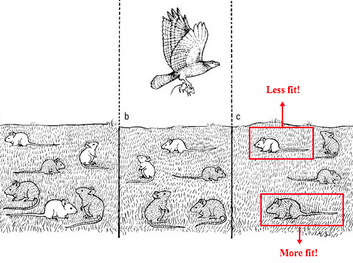
Note: UBC Blogs
How does this translate to real-world examples? Phenotypes! 🎨
Environments are constantly changing, and these changes can have a significant impact on the populations that live within them. For example, changes in temperature, precipitation, or the availability of food can all affect the survival and reproduction of organisms. These changes can also apply selective pressures to populations, meaning that certain traits that were once advantageous may become less so, while others may become more advantageous.
For example, imagine a population of lizards living in a desert environment. In this environment, lizards with light-colored scales are at an advantage because they are better able to thermoregulate and avoid overheating. However, if the climate were to change and the desert became more lush and moist, the selective pressure would change and lizards with darker scales would have an advantage because they would be better able to camouflage themselves in the new environment.
Phenotypic variations also play a role in how well an organism can adapt to its environment. Phenotypes are the observable characteristics of an organism, such as its size, shape, color, or behavior. Some variations in phenotypes can significantly increase or decrease the fitness of an organism in a particular environment.
For example, a variation that leads to the development of larger or stronger muscles could significantly increase an organism's fitness in an environment where strength is important for survival and reproduction. On the other hand, a variation that leads to a decrease in vision may significantly decrease an organism's fitness in an environment where visual acuity is important for survival.
Overall, the environment is an important factor in shaping the evolution of populations and species. The selective pressures that are applied by the environment can lead to changes in the frequencies of certain traits over time, and the phenotypic variations of an organism plays a crucial role in determining how well it can adapt to its environment.
7.3 Artificial Selection
Artificial selection is the process by which humans intentionally breed organisms with certain desired traits. This is in contrast to natural selection, which is the process by which certain traits become more or less common in a population based on how well they enable the individuals possessing them to survive and reproduce. 🐔
Humans have been using artificial selection for thousands of years to domesticate plants and animals, and create new varieties that are better suited to human needs and preferences. For example, by selectively breeding dogs over thousands of years, humans have created a wide variety of breeds that vary in size, shape, and behavior. Similarly, by breeding plants, humans have created new varieties that are more resistant to diseases, pests, or environmental conditions.
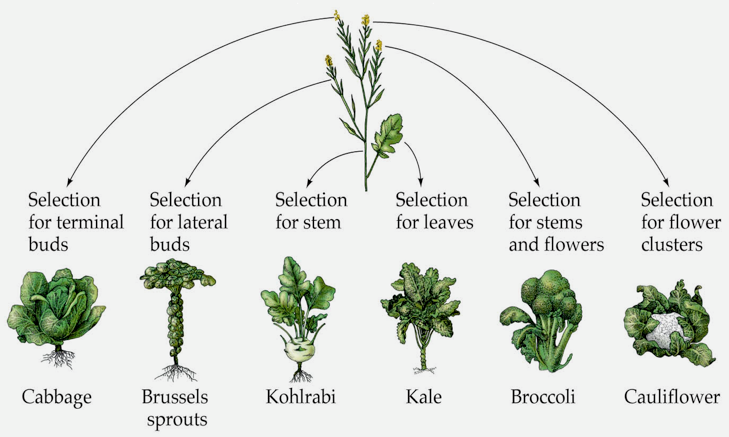
Source: Inspirit
Artificial selection can also be used to increase or decrease the variation within a population of organisms. For example, farmers may selectively breed plants with large fruit or high yields to increase the frequency of those traits within the population. Conversely, farmers may selectively breed plants with small fruit or low yields to decrease the frequency of those traits.
Artificial selection can also lead to the development of new species. For example, if a population of domesticated animals or plants is isolated from its wild ancestors and is not able to interbreed with them, it can become a distinct species over time.
7.4 - 7.5 Applying Population Genetics via Hardy-Weinberg Equilibria
In addition to natural selection, evolution is also driven by random occurrences. These random occurrences can include mutations, genetic drift, and migration/gene flow. 🍀
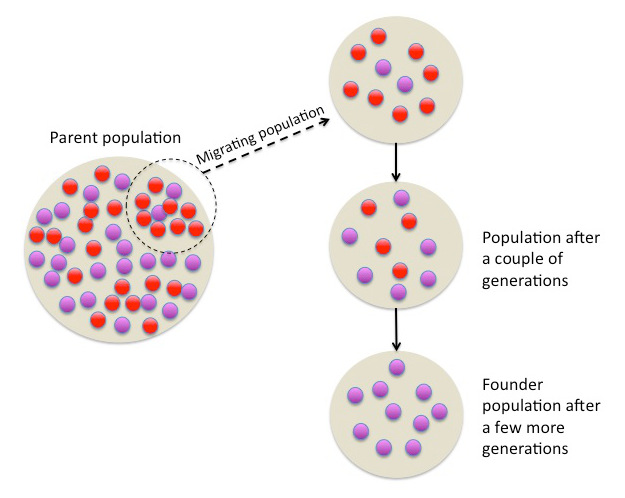
Source: Shmoop
Mutation is a random process that occurs when a mistake is made during DNA replication or when DNA is damaged by environmental factors. These mistakes can lead to changes in the DNA sequence, which can in turn result in changes in the phenotype of an organism. Some mutations have no effect on the organism, while others can be beneficial, harmful, or have no effect on the organism's fitness.
Genetic drift is a non-selective process that occurs in small populations. Genetic drift refers to the random fluctuations in the frequency of alleles (different versions of a gene) in a population that occur due to chance. Genetic drift can cause certain alleles to become more or less common in a population, even if they do not confer any advantage or disadvantage to the organism.
Two types of genetic drift that occur in small populations are bottlenecks and founder effect. A bottleneck is a reduction in population size, which can result in the loss of genetic variation. A founder effect is when a small number of individuals migrate to a new area and establish a new population. These individuals may not be representative of the genetic diversity of the original population, leading to a loss of genetic variation in the new population.
Migration, or gene flow (in a literal sense), is the movement of individuals or their genetic material from one population to another. Migration can drive evolution by introducing new genetic variation into a population or by removing genetic variation from a population.
For example, if a population of birds living in one area migrates to another area with a different environment, the birds may be more or less adapted to the new environment. If the migrants have a higher fitness than the resident population, they may be able to outcompete the residents and change the genetic makeup of the population over time.
When looking at non-evolving populations, the Hardy-Weinberg equilibrium is a theoretical model that describes and predicts the allele frequencies. It serves as a baseline from which we can observe and measure deviations due to the evolutionary forces previously discussed, such as genetic drift, mutation, migration, non-random mating, and selection. This allows population geneticists to study the effects of these forces on allele frequencies and understand how and why populations evolve over time.
7.6 - 7.7 Proving Evolution Through Common Ancestry
Evolution is a scientific theory that is supported by a wide range of evidence from many different disciplines. For example, geographical, geological, physical, biochemical, and mathematical data all provide evidence for evolution. 🖥️
One type of evidence for evolution is the distribution of living organisms and their fossils. For example, the geographical distribution of different species on different continents and islands provides evidence for the theory of plate tectonics and biogeography, which explains how continents and islands have moved over time and how this has influenced the distribution of living organisms. Similarly, the fossil record provides evidence for the gradual change of species over time.
Another type of evidence for evolution is the molecular and cellular similarities between different organisms. Many fundamental molecular and cellular features and processes are conserved across organisms, indicating that they have a common ancestry. For example, all organisms use DNA as their genetic material, and they all have similar mechanisms for replicating and repairing DNA.
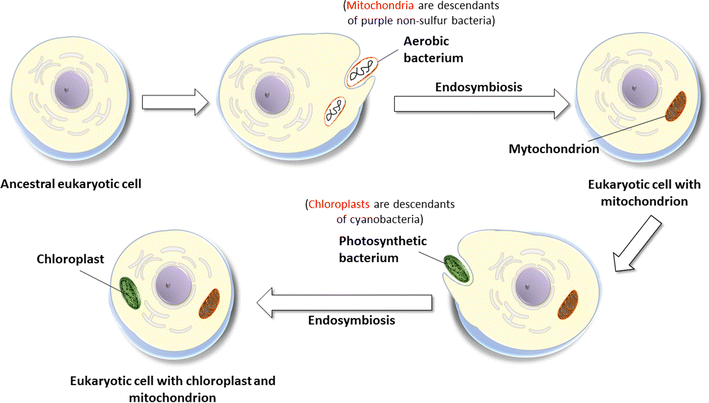
Source: ResearchGate
Structural evidence also indicates common ancestry of all eukaryotes. Eukaryotes are organisms whose cells have a defined nucleus and other membrane-bound organelles. The structural similarities in the organelles of eukaryotic cells, such as mitochondria and chloroplasts, indicate that they share a common ancestor. The evidence also suggests that mitochondria and chloroplasts were once independent organisms that were engulfed by a host cell, in a process called endosymbiosis, which is now considered one of the key events in the evolution of eukaryotic cells.
7.8 & 7.10 Evolution is a Continuous Process that Leads to Speciation!
Guess what? All species have evolved and continue to evolve over time! ⌛
With this in mind, speciation is the process by which one species diverges into two or more descendant species. There are several different mechanisms that can lead to speciation, but one of the most common is when two populations of a species become reproductively isolated from each other. This can happen in a variety of ways, such as geographical isolation, behavioral isolation, or temporal isolation.
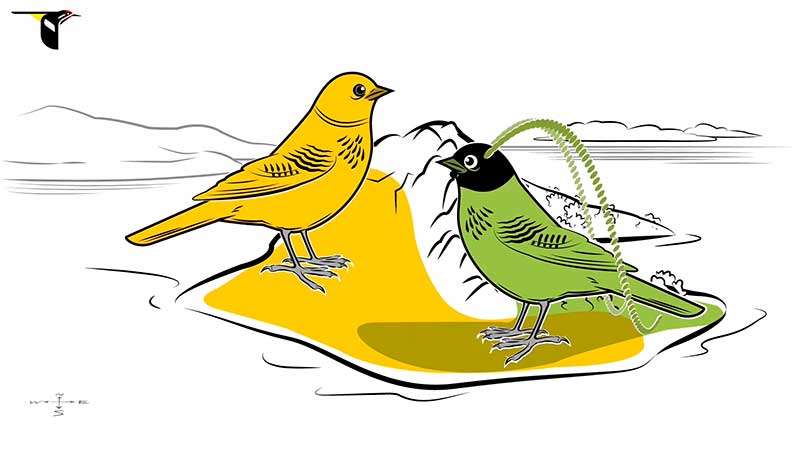
Source: Bird Academy
7.9 Phylogeny
Phylogenetic trees and cladograms are both tools used to show relationships between different lineages of organisms, but they have some key differences. 🌲
A phylogenetic tree is a diagram that shows the evolutionary relationships between different groups of organisms. It is a branching structure that represents the evolutionary history of a group of organisms, with the most recent common ancestor at the base and the most distantly related organisms at the tips of the branches. Phylogenetic trees are based on the concept of a common ancestor, which means that all the organisms represented on the tree share a common ancestor at some point in the past.
Phylogenetic trees can also be calibrated using fossils or molecular clock. Fossils are the remains of ancient organisms that are found in rock formations. By comparing the characteristics of fossils to those of living organisms, scientists can infer the evolutionary relationships between different lineages. Molecular clocks are a way of estimating the time at which evolutionary events occurred by comparing the genetic differences between different organisms.
A cladogram, on the other hand, is a diagram that shows the evolutionary relationships between different groups of organisms based on shared characteristics, known as synapomorphies. A cladogram is a branching structure that represents the evolutionary history of a group of organisms, but the branches do not represent time in the same way as a phylogenetic tree. Cladograms are based on the concept of a monophyletic group, which means that all the organisms represented on the tree share a common ancestor.

Source: Lumen Learning
7.13 Where Did Life on Earth Begin?
The origin of life on Earth is a complex and still-unanswered question in science. However, scientists have proposed several hypotheses about how life may have originated on our planet, and these hypotheses are supported with scientific evidence. 🌎
While the exact mechanism of how life originated on Earth is still unknown, scientists continue to study and gather evidence to support these hypotheses. Each hypothesis has its own strengths and weaknesses and new discoveries and research may provide new insights and information that can help to further refine or even replace such hypotheses.
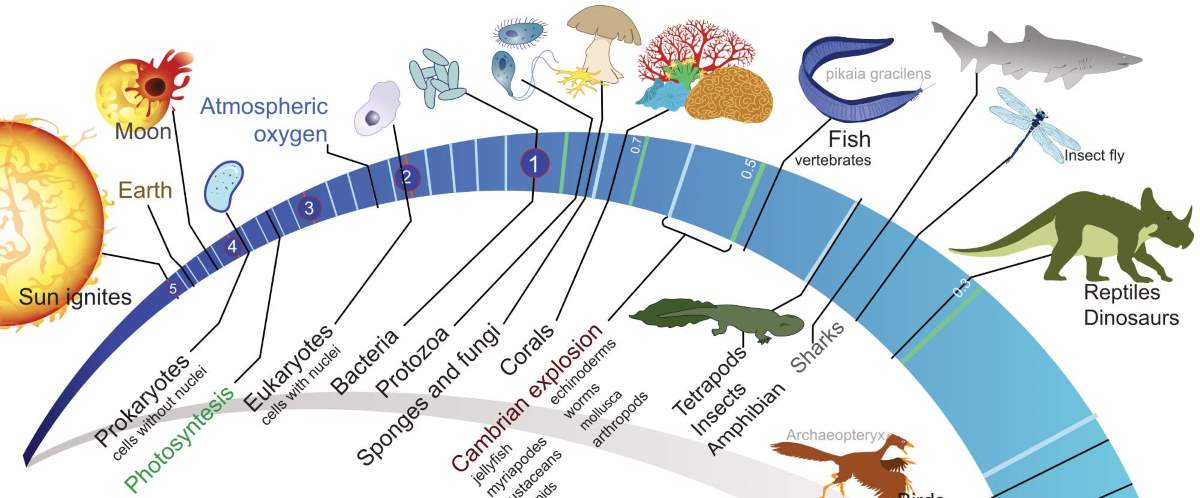
Source: Our Planet
Good news for you: the study of the origin of life is an ongoing area of research in many scientific disciplines such as astrobiology, biochemistry, and genetics, in case you're interested in dwelling upon such a complex and multifaceted question!
Important Formulas
Hardy-Weinberg Equilibrium:
p^2+ 2pq + q^2 = 1
p + q = 1
Browse Study Guides By Unit
🧪Unit 1 – Chemistry of Life
🧬Unit 2 – Cell Structure & Function
🔋Unit 3 – Cellular Energetics
🦠Unit 4 – Cell Communication & Cell Cycle
👪Unit 5 – Heredity
👻Unit 6 – Gene Expression & Regulation
🦍Unit 7 – Natural Selection
🌲Unit 8 – Ecology
📚Study Tools
🧐Exam Skills

Fiveable
Resources
© 2025 Fiveable Inc. All rights reserved.